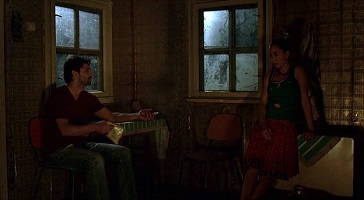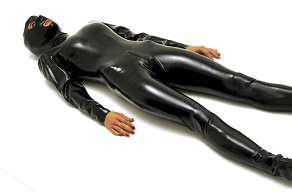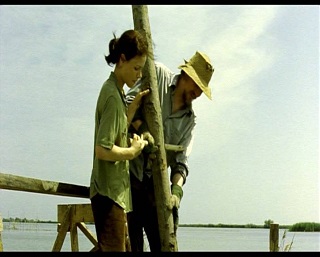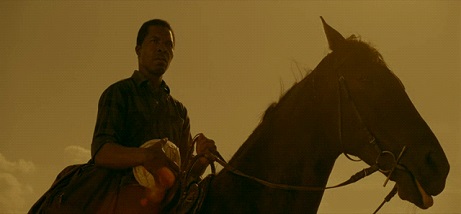Hajnal Király
Places of Encounter: Thematising Cultural Exchange in Contemporary Hungarian-Romanian Co-Productions[1] (download pdf)
hajnal.kiraly@gmail.com
Abstract. The dissimilarities between contemporary Hungarian and Romanian cinema, detectable in the representation of postcommunist phenomena and different stylistical choices – a formalist, poetical approach to these topics in the case of Hungarian films and a preference for realism and “immediacy” in the Romanian ones – appear reconciliated and even reflected upon in co-productions between the two countries. Besides bringing together different languages, acting and directorial styles, as well as geocultural settings, the co-productions in question often thematise cultural encounters, communication issues, border crossings and identity quests. These topics are mostly figurated by heterotopia enhancing in-between-ness and liminality, such as the no man’s land in Morgen (Marian Crișan, 2010) or the house built on water in Delta (Kornél Mundruczó, 2006). In line with Ewa Mazierska’s assumptions regarding the tendency of co-productions to produce heterotopias, I propose to analyse a corpus of four Hungarian-Romanian co-productions with the aim to reveal the transnational dynamics reflected in the diegeses of these films, most importantly in their choice of heterotopias that are, in Foucault’s definition, in a reflexive relationship with all the other sites and social discourses. I will also argue that these films can be ultimately regarded as heterotopias themselves, enabling communication and a mutual understanding between the two cultures. I will also show how this exchange is orchestrated by directors who fulfil the criteria of the radicant artist, a traveller who excels in translating ideas, transcoding images and transplanting behaviours (Bourriaud 2009, 22).
Keywords: co-productions, heterotopia, accented cinema, radicant, contemporary Hungarian and Romanian cinema
Introduction
Despite a similar and interconnected socio-political background, contemporary Hungarian and Romanian cinema shows striking differences in terms of dealing with postcommunist phenomena such as memory work, migration, the effects of globalisation and those of the adherence to the European Union. In terms of the figurative representation of the postcommunist subjectivity and identity crisis, the two cinemas display an opposite movement: while in Hungarian films the body becomes a figure reinforcing the Western concepts and discourses on alienated subjectivity, capitalist production, consumerism, fetishism and spectacle, Romanian films seem to be confronting Western theories and concepts of the body, national and sexual identity, and memory with the Romanian socio-political actuality. Stylistically this difference is reflected in an exaggerated formalism that characterises Hungarian films as opposed to a preference for immediacy and micro-realism alternating with an alienating camera work in the case of Romanian cinema. I argue that in Hungarian-Romanian co-productions the collision between the two cinematic traditions can be seen as the articulation of cultural specificities and of a dynamics of cultural interactions. In my presentation I propose to analyse four Romanian-Hungarian co-productions that, intriguingly, thematise cultural, ethnic relationships between the two countries, doubling, in an ironical way, the transnational dynamics of co-production.
Hungarian director Kornél Mundruczó’s Delta (2006), set in Romania, with mainly Hungarian actors, tells the story of a young man returning from the West to the region of the Danube Delta , inhabited by both ethnic Hungarians and Romanians who are regarding with suspicion his project to build a house on the water and his too intimate relationship with his sister. This ultimately triggers the anger of the community and causes their death.
Szabolcs Hajdu’s Bibliothèque Pascal (2010), set and shot in Romania, partly with Romanian actors and crew, focuses on the narration of a prostitute who returns to Romania from the UK and applies for the custody of her daughter. This film appears as a cross-breeding between the two mentioned cinematic paradigms, its visual stylisation corresponding to the magic realism of the protagonist’s narration, a distinct feature of Hajdu’s films, being anchored in the harsh reality of the state official’s office (a recurrent location in Romanian films) and his practical approach to the case in question. Hajdu’s most recent film, Mirage (2014) is already set in Hungary, with mostly Romanian actors and a surprising participation of Isaac de Bankolé, and displays a utopian vision of a farm where Romanian gangsters acting like cowboys keep Hungarians as slaves. Finally, Romanian director Marian Crişan’s film Morgen (2010), set on the Romanian border town of Salonta, is the story of an unlikely friendship between Nelu, a Romanian man working as a security guard in a supermarket (played by a prominent ethnic Hungarian actor of the Hungarian Theatre in Cluj, Romania) and an illegal emigrant (a Kurdish refugee, according to the screenplay, played by Turkish actor Yilmaz Yalcin), stuck on the way towards Germany.
In these co-productions the central topic of transnational communication characterises by a series of recurrent features that all four films share: the figurative role of the spoken idioms, the recurrent topic of protection and dependency, the preference for heterotopias and the inclusion of a third, Western party in the narrative, figurative of the economic background of the co-productions. In what follows I aim to prove that these aspects are not only figurative of intercultural exchange, but they overtly thematise the economical and even (cultural) political implications of co-productions orchestrated by what Bourriaud calls a “radicant artist,” (2009) who moves and translates freely between cultures and languages.
The Figurativity of “Accented” Films
All four films discussed here are multilingual: besides Romanian and Hungarian, occasionally other languages occur: English and Spanish (used between the female protagonist Mona and Pascal, the brothel owner in Bibliothèque Pascal, the mysterious black man and the Romanian gangster-cowboys in Mirage), as well as bits of German and Turkish (or Kurdish?) in Morgen. Besides an evident reflection on a multifaceted European identity, constantly replanned due to border shifts and crossings, linguistic diversity often figurates the economic exchange between Hungary and Romania, as well as a Western party, involved in the cinematic production process. In Delta, for example, the intrusion of Romanian ethnic Hungarians (speaking a dialect of Hungarian) into the Paradisiac waterland, bringing huge (phallic) poles of wood that Mihail paid for with Euros, in a way replicates the arrival of an international film crew eager to transform the unspoiled landscape into a commercial product. Similarly, foreign language (together with foreign currency) appears as an instrument of a dodgy business in Bibliothèque, Mirage and Morgen, too.
The figurative role of multilinguality is especially prominent in films of Szabolcs Hajdu. As Balázs Varga argues, linguistic hybridity and miscommunication only emphasise the sense of being lost or in-between, prevalent in his films. In these linguistically charged situations the capacity of translation is crucial: characters manage to come out from a pressing situation depending on their ability to switch between languages. In White Palms (2007), for example, in Canada, Dongó, the main protagonist, is more appreciated by his student for his improving English than for his professional skills (Varga 2015, 8). This great adaptability of the East European individual to the demands of the Western market is best represented by the character of Mona in Bibliothèque: she switches without effort between four languages (Hungarian, Romanian, English, Spanish), depending on location and situation. However, her speech is always “accented:” her Romanian has Hungarian accent, her Hungarian bears the trace of ethnic Hungarians from Romania and her English has East European accent. In these films spoken language, either Hungarian or Romanian, often bears imperfections, detectable in pronunciation and omission of cultural nuances, resulting in what Hamid Naficy calls “accented cinema” in connection with diasporic cinema. Accented language as a source of misunderstandings and miscommunication becomes a signifier of national identity and otherness, that is, of a cultural discourse different from the official one: in Bibliothèque Pascal Mona speaks a very good Romanian gramatically, though with a strong accent, and she is immediately detected as non-Romanian by Viorel, the alleged father of her daughter. As Katalin Sándor in her analysis of this film argues, “Mona defines herself as ‛jumi-juma’ (‛fifty-fifty’) as Romanian ̶ Hungarian, her identity being negotiated in-between languages, cultures, ethnicities.” As such, “the ethnic-linguistic hybridity is not only manifest in a discursive-conceptual but also in a corporeal way”, manifest in Mona’s accent: “while being completely fluent in Romanian, her body, the organs of speech remember and reproduce the sonorous memory of another language” (Sándor 2014, 89).
Mona’s reply, uttered in Romanian (“You speak as if there were only Romanians on the Earth, but there are Hungarians, too. And some are fifty-fifty”), however, goes beyond a simple statement of her nationality, revealing a clear irritation regarding the official language or as it were, official discourse [Fig.1.].

[Fig.1.] “some are fifty-fifty” – Mona and Viorel in Bibliothėque Pascal
In a similar vein, although they speak the same language, at first Mona apparently fails to understand the adoption officer’s intention to help her with a lie that seems realistic instead of the truth that appears as surrealistic. And conversely, the officer, though understands Mona well, fails to detect the trauma that eventually lies behind the fantastic details of Mona’s narration. Accent becomes an unmistakable trace of identity in these films, both of the character and actor, a sign of home even in circumstances of displacement such as migration, exile, or work-related journey. In Morgen, for example, Nelu’s accent points both at the actor’s ethnic Hungarian origin, as well as the linguistic and cultural influence of Hungary’s geographic proximity (the majority of the town’s population are ethnic Hungarians). Similarly, in press material and interviews Behran is referred to as both a Turkish and a Kurdish immigrant, which raises the problematic relationship of identity with nationality and ethnicity.[2] Although the spectator cannot judge whether Behran speaks with an accent or not, it is intriguing that the two actors and the protagonists played by them participate in a mirror structure: the ethnic minority Hungarian playing a majority Romanian and the representative of the Turkish majority playing an ethnic minority.
According to Hamid Naficy, “it is impossible to speak without an accent”. Consequently, accent can be one of the most distinguishing traits of personality:
Depending on their accents, some speakers may be considered regional, local yokel, vulgar, ugly, or comic, whereas others may be thought of as educated, upper-class, sophisticated, beautiful, and proper. As a result, accent is one of the most intimate and powerful markers of group identity and solidarity, as well as of individual difference and personality. (Naficy 2001, 23)
Naficy applies the term “accented cinema” for exilic and diasporic cinema not only due to the regular accented speech of the protagonists ̶ this is just one of the characteristics of the films in question. The syntagm rather refers to a cinema that “derives its accent from its artisanal and collective production modes and from the filmmakers’ and audiences’ deterritorialized locations.” (2001, 23) Although the films under analysis do not belong to the exilic and diasporic cinema in its more restricted sense (involving a permanently dislocated director and topics related to various aspects of life in diaspora), I contend that they still fulfil the most specific requirements of accented cinema as described by Naficy. They are low budget, multilingual films, often characterised by a convoluted production process, multisource funding and collective production. The three main traits of accented cinema ̶ interstitial, partial, multiple ̶ also apply to most aspects of these films: they are interstitial (that is, articulating difference) in terms of their topics, choice of characters, actors and sometimes a mixture of genres and cinematic traditions (Naficy 2001, 46). In concordance with this, they are only partially adapting to any cinematic paradigm and, as an alternative, choose multiplicity of styles and cultural voices.
Additionally, their directors are often crossing borders, just like their characters involved in a great variety of journey narratives, including homecoming scenarios. In the case of films of Szabolcs Hajdu, the female characters are played by his fetish actress who happens to be his wife, Orsolya Török-Illyés, an ethnic Hungarian woman from Transylvania, Romania. In Bibliothèque and Mirage (both featuring Romanian actors also) her bodily presence mediates between the two, Hungarian and Romanian cultures not only on a diegetic, but also the metadiegetic level of the co-production process, due to her ability to translate between the two cultures and even to catalyse the possible tensions and miscommunications. I contend that the recurrent topic of freedom and authority, protection and dependency, often implying a third, Western party, is related in all four films to money and profit, figurating, again, the East-West relationships in general and the given co-productions in particular.
Protection, Dependency and the Third, Western Party
In Delta, the protagonist Mihail, arriving home from the West, cannot buy the acceptance of the community he depends on and is unable to protect himself from its rage. He can buy services from the community he once left with Euros, but he is regarded with suspicion, as an intruder menacing the old equilibrium of the village and finally is eliminated as an unwanted element. Similarly, the topic of slavery in Mirage figurates an economic dependence in Hajdu’s utopistic vision of Romanian-Hungarian relationships: on the farm in ruins, situated somewhere in the Puszta, a typical Hungarian landscape close to the Romanian border, Romanian cowboy-gangsters (played by Romanian actors displaced from their natural Romanian setting), who also speak English when it comes to business, keep Hungarians as agricultural slaves, including a woman (played by Orsolya Török-Illyés), the mistress of the gangster’s leader. In this situation revolving around Hajdu’s favourite topic of freedom and oppression arrives the mysterious black man, whose money might offer a solution of escape for the oppressed, and ultimately causes the self-annihilation of the community in question. In a similar vein, in Bibliothèque, the act of converting of the East European body into a Western European cultural product and foreign currency reiterates the same topic of the colonising effect of the Western influence, also detectable in co-productions. A number of studies have already emphasised the colonising Western male gaze represented in this film in the setting of a brothel where the exquisite clientèle is served with Eastern European bodies re-enacting scenes from Western-European cultural heritage. The unknown, thus untouchable Eastern-European body can be approached only if culturally “domesticated,” thus Mona, the “fifty-fifty” Hungarian-Romanian woman is forced to enact, in turns, Joan of Arc and Desdemona. In the Desdemona-scene, the “alien” female body and Shakespeare’s drama meet in a fetishistic object-image, a figure covered all over in black plastic stretchy clothes. Besides acting as an artificial skin that excludes all authentic social communication between the perpetrator-coloniser and his victim, the plastic cover works as an attractive “packaging” that exposes her as a commodity, a common capitalist currency. The image of this morbidly sexy body (recalling the Catwoman from the Batman films) appears on the poster of the movie, becoming the “official image” of the film conceived as just another Eastern European product, turned into a Western commodity. While we can agree with Aga Skrodzka in refusing a too radical condemnation of the Western gaze turning the Eastern female body into a sexual object (Skrodzka 2015, 124), we can still argue that this body, bearing the traces of cultural memory, is both a transnational and a transitional object involved in a complex intercultural translation between East and West [Fig.2.].

[Fig.2.]. Mona’s body as (erotic) product in Bibliothėque Pascal
Besides the East-West connection, the framing scene at the custody office also displays a peculiar form of protection and dependency, termed by Mónika Dánél as the ambiguity of authority and solidarity, detectable between the officer and Mona in the use of languages and gestural expression (Dánél 2015, 47).
Finally, in a most emotional example, in Crişan’s film the relationship between the two lonely men epitomises this protection-dependency correlation, figurated by Nelu’s parodic security-guard image and the motorcycle with the side wing. After accepting the foreign currency from the Kurdish immigrant that he exchanges into Romanian Lei, after repeated attempts, at the end he carries across the border his friend, with whom he communicates perfectly without a shared language [Figs.3–4.].


The co-productions under analysis also involve a third, Western party, most often Germany, France, the UK and the Netherlands, figurated in the narratives through a character returning home (in Delta), a cosmopolitan businessman (Bibliothèque) or a visiting, mysterious foreigner in Mirage, who represent the Western gaze. Ironically, neither the businessman from Bibliothèque, nor the football player are innate Western citizens: they both represent an “adopted,” “accented” Western gaze associated with a self-colonising attitude and (in both cases) dodgy businesses thriving on the outskirts of a Western capitalist, global economy. What Svetlana Boym considers a Russian phenomenon, the films of the “return of the prodigal son” be it an émigré or an international prostitute who comes back to the motherland after many misadventures abroad” also appears in the films coming from the former Eastern bloc and are meant to thematise the encounter and the aforementioned dependency relationship between the East and the West. The figure of the foreigner in literature and film is used to defamiliarise the local culture, to give an alternative perspective on it; however, in Delta or Bibliothèque the native is not allowed to fall back in love with his own homeland, to rediscover the pleasure of the familiar, as Boym points out about Russian films (Boym 2001, 65). In Delta this return appears as a disruptive, colonising, aggressive act, symbolised by the phallic wooden poles bought with Euros, and inserted in the unspoiled water by Mihail [Fig.5.]. In Bibliothèque, the return doesn’t necessarily imply the existence of a home: in the closing scene we see Mona and her daughter in a furniture supermarket, Kika or Ikea, an imitation, a globalised simulacrum of a home.

In all the films under analysis, the Western element, symbolised by foreign currency, a fetishising gaze, or consumerism also appears as a cause of disruption inside a Romanian-Hungarian community: Mihail from Delta is murdered, Mona loses her family after becoming a sexual object in a Liverpool brothel, the Turkish migrant cannot continue his journey to Germany because he lacks enough Euros and he is stranded at the border, causing serious problems for Nelu, while in Mirage the arrival of a black man with a football full of money stirs a war between the local gangsters. Isaac de Bankolé’s “reframed” image of the lonely wolf, a mysterious Jim Jarmusch franchise since The limits of control (2009), is the key to the Western audiences and thus Western money. With an ironical switch, after everybody got killed, the black man takes his suitcase (“a multifaceted metaphor of the mobility of identity” according to Naficy [2001, 266]) and the football with the money and leaves on horseback, stylishly disappearing into the sunset on the Puszta [Fig.6.].

Many of the characters representing local authority or the Western party, or even those returning home from abroad (with money or without) correspond to what Naficy calls “a shifter:” an “operator” in the sense of being dishonest, evasive, and expedient, or even being a “mimic,” “a producer of critical excess, irony, and sly civility” (Bhabha 1994). As Naficy argues, in the context of so-called “border filmmaking”, “shifters are characters who exhibit some or all of these registers of understanding and performativity. As such, they occupy a powerful position in the political economy of both actual and diegetic border crossings” (2001, 32). The brothel manager Pascal, the adoption officer and even Mona in Bibliothèque, the border police in Morgen and the gangsters in Mirage gain their power, as Naficy puts it, “from their situationist existence, their familiarity with the cultural and legal codes of interacting cultures, and the way in which they manipulate identity and the asymmetrical power situations in which they find themselves”. (2001, 32) Extra-diegetically the creators (directors, producers, actors) of these co-productions can also be considered shifters, “mimics” adapting to and manipulating cultural codes in order to critically reflect upon transnational communication and the authorities orchestrating this communication.
In these films bodies are not only objects of exchange between countries, but often appear as heterotopias themselves, become meeting ‛sites’ between East and West. The body of Mona in Bibliothèque Pascal functions both as a ‛container of memories’ of her home and a surface onto which Western cultural stereotypes and prejudices can be projected. As I have already argued, her body is negotiating, on an extra-diegetic level, the meeting between Hungarian and Romanian cultures. This results in the heterotopia of the film itself, presenting a compelling mixture between the formalism characteristic of most contemporary Hungarian films and the hyperrealism of the so called Romanian New Wave.
Heterotopias as Scenes of Intercultural Dynamics
According to Naficy, the preoccupation with territoriality, rootedness and geography are distinct features of accented films. As he argues: “Because they are deterritorialized, these films are deeply concerned with territory and territoriality. Their preoccupation with place is expressed in their open and closed space-time (chronotopical) representations.” (2001, 5) Besides chronotopes (of which the most prominent is the house, the new or left-behind home of the protagonists) heterotopias are basic ingredients of an accented cinematic discourse on identity, cultural and economic interaction, as well as power relationships.
The fair, the train station, the police station, the brothel and the house built on water are all localisable places, whose in-betweenness, transitory and/or liminal character contributes to a figural discourse on the cultural implications of mobility and immigration, as well as on Eastern European identity. These places are what Foucault calls ‛other places’ being in a metaphorical, reflexive relationship with society while gathering more than one aspect of it. In Foucault’s definition, heterotopias are ‘in relation with all the other sites, but in such a way as to suspect, neutralize, or invert the set of relations that they happen to designate, mirror, or reflect’ (Foucault 1986: 24). As an illustration of Foucault’s concept, Szabolcs Hajdu’s Mirage takes place somewhere in the middle of the nowhere, on the Hungarian Puszta. This typical Hungarian landscape closely related to national identity (many poets have dedicated poems to it) is “contaminated” here with a building in ruins that opens up a historical dimension, as well as the traces of agricultural and industrial lifestyle, all inhabited by Romanian cowboys and their Hungarian slaves. The house appears here as “a threatened physical place that may experience successive possessions, dispossessions, and repossessions” (Naficy 2001, 169), a dynamics that culminates in the final armed clash between the gangsters and slaves, ending with the elimination of the former and the re-possession of house and land.
This distorted vision of intercultural relationships is reflected upon by the very title of the film, Mirage, an allusion to the optical phenomenon frequently visible in the Puszta, showing things upside down, as reflected by the last image of the film. As a kind of distorted mirror, the film as a mirage itself can be seen as a heterotopia that reflects heterogeneous cultural and cinematic influences and references from Hollywood film genres to the trend of slow cinema and European arthouse film tradition, merging the global with the local into a visionary representation of what Svetlana Boym calls the “glocal.” (Boym 2001, 67) This also corresponds to the already mentioned interstitiality of accented cinema, defined by Naficy as the ability “to operate both within and astride the cracks of the system, benefiting from its contradictions, anomalies, and heterogeneity. It also means being located at the intersection of the local and the global, mediating between the two contrary categories, which in syllogism are called “subalternity” and “superalternity.” (2001, 46)
The preference for settings at geopolitical borders and the topic of border crossings involving issues of ethnic and national identity defines the four films under analysis as “border films” (Naficy 2111, 239) rich in heterotopia that appear as “portal places charged with intense emotions, involving fearful escapes, tearful departures, sudden entrapments, devastating rejections, joyful arrivals, and a euphoric sense of liberation that cannot be recuperated easily.” (Naficy 2001, 238)
As Ewa Mazierska argues in her article revealing Eastern European co-productions as productions of heterotopias, in these films the international collaboration is reflected in the diegesis, revolving around cross-cultural communication and actions that take place in or generate heterotopias (2012, 484). This is the case of Delta, a Hungarian-German co-production set in the Romanian Danube Delta, casting Hungarian actors, a story about the hostility against the new (a heterotopic house built on the water) and the Western influence in a traditional society in which enmities between ethnic Romanians and Hungarians are not completely resolved. Bibliothèque Pascal, a Hungarian-Romanian-German-British co-production casting both Hungarian and Romanian actors, with the creation of the brothel-library heterotopia reflects on the Western Gaze on the Eastern European body, both that of the actor and of the protagonist, as affordable and exotic product. The house on the water, the brothel disguised as library are heterotopias that, as Mazierska would argue, exist outside the normal political, cultural and sometimes physical order (2012, 502). They are places of transition illustrating the issues of increased mobility in Europe, transnationalism and cultural communication, of which co-productions became the most compelling examples, other places themselves, facilitating the meeting of distant, sometimes incompatible places and cultures.
Conclusion: Co-productions and the Radicant Artistic Mode
As we have seen, the co-productions discussed above are often thematising the cultural interactions required by the production process in their very diegesis, through their “accented” characters involved in situations of translation, miscommunication, various types of journey and return narratives, the topic of (economic) protection and dependency, the presence of a third, often Western party (owner of foreign currency), as well as the preference of heterotopic places of transition, borders and other liminal spaces. As such, although they don’t belong to what Naficy terms as exilic cinema, nevertheless they fulfil the requirements of border cinema and accented cinema. This latter category doesn’t simply refer to the accented speech of the protagonists, but also to an accented cinematic language detectable in its difference from mainstream narratives, genres and production modes. Additionally and most relevantly, as Naficy puts it, “accented filmmakers are not just textual structures or fictions within their films; they also are empirical subjects, situated in the interstices of cultures and film practices, who exist outside and prior to their films.” (2001, 4) As constant travellers between cultures, the filmmakers Mundruczó, Hajdu and Crișan can be considered “shifters” themselves, “with multiple perspectives and conflicted or performed identities”. (2001, 32)
Both terms of “accented” filmmaker and “shifter” describe an artistic mode that, beyond exilic cinema, characterises what Nicolas Bourriaud terms the artistic superrealism of our times. The case of the directors referred to above epitomises the definition of the radicant artist who adapts freely to different conditions of production, acting styles, language, as well as to the different stylistic paradigms of cinematic traditions involved. As Bourriaud argues,
To be a radicant means setting one’s roots in motion, staging them in heterogeneous contexts and formats, denying them the power to completely define one’s identity, translating ideas, transcoding images, transplanting behaviours, exchanging rather than imposing the figure of the wanderer at the heart of contemporary artistic creation, accompanied by a domain of forms, the journey form, as well as an ethical mode, translation (2009, 22).
In the light of these definitions, all four films referred to above fulfil what Bourriaud calls the surest criteria to judge an artwork today: the capacity of displacement and the figuration of a productive dialogue with different contexts and cultures (2009, 105) ensures their dislocation from a provincial, Eastern European context, placing them in the global discourse of mobility and identity.
References
Bourriaud, Nicolas. 2009. The Radicant. New York: Lucas & Sternberg.
Boym, Svetlana. 2001. The Future of Nostalgia. New York: Basic Books.
Dánél, Mónika. 2015. A megjelenítés gesztusai, (belső) képek valósága Hajdu Szabolcs filmjeiben. [The Gestures of
Representation, the Reality of (Mental) Images in Szabolcs Hajdu’s Films] Prizma. Film & Kult. vol. 13, 42–49.
Foucault, Michel. 1986. Of Other Spaces. Diacritics. vol. 16. no. 1. 22–27.
Kuzma, Konstanty and Moritz Pfeifer, 2011. Marian Crișan on Morgen. East European Film Bulletin. April 2012:
https://eefb.org/archive/june-2011/tiff-cluj-2011/marian-crisanon-morgen/ (Last accessed 19.09.2016)
Mazierska, Ewa. 2012. International Co-productions as Productions of Heterotopias. In A Companion to Eastern European Cinemas, ed.
Anikó Imre, 483–503. Oxford: Wiley-Blackwell.
Naficy, Hamid. 2001. An Accented Cinema. Exilic and Diasporic Filmmaking. Princeton and Oxford: Princeton University Press.
Sándor, Katalin. 2014. Heterotopias of/and “Living Images” in Szabolcs Hajdu‛s Bibliothèque Pascal (2010). Ekphrasis. Images, Cinema,
Theory and Media. vol. 12, Issue 2/2014, 79 ̶ 92.
Skrodzka, Aga. 2015. Cinematic Fairy Tales of Female Mobility in Post-Wall Europe: Hanna v. Mona. East, West and Centre. Reframing
Post-1989 European Cinema, eds. Michael Gott and Todd Herzog, 109–124. Edinburgh: Edinburgh University Press.
Varga, Balázs. 2015. Terek és szerepek. Tér és identitás Hajdu Szabolcs filmjeiben. Prizma. Film & Kult. vol. 13, 4–13.
Veres, Ella. 2012. Marian Crișan’s Morgen. An Interview with Marian Crișan. Bomb Magazine. March 20 2012:
http://bombmagazine.org/article/6489/marian-cri-an-s-em-morgen-em (last accessed: 19.09.2016).
[1] This work was supported by the project entitled Space-ing Otherness. Cultural Images of Space, Contact Zones in Contemporary Hungarian and Romanian Film and Literature (OTKA NN 112700).
[2] See, for example, Kuzma and Pfeifer (2011) and Ella Veres (2012).
